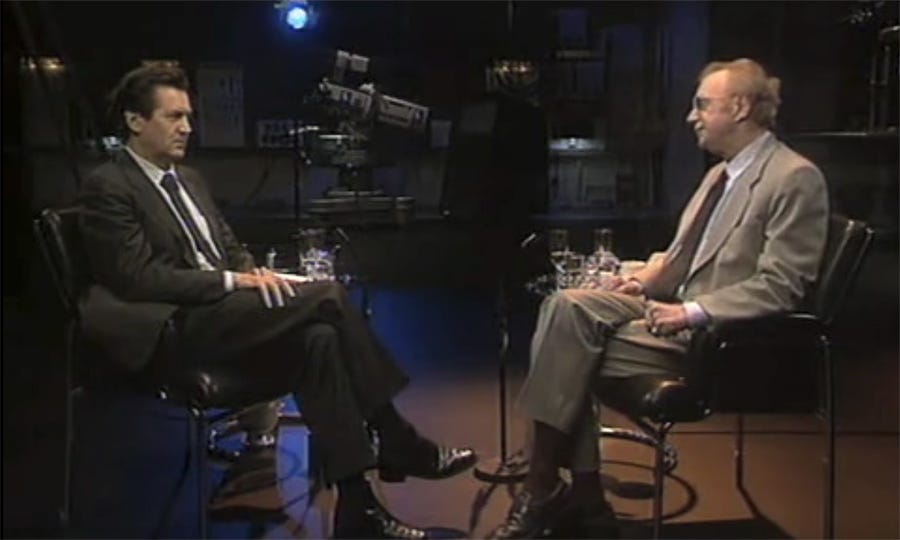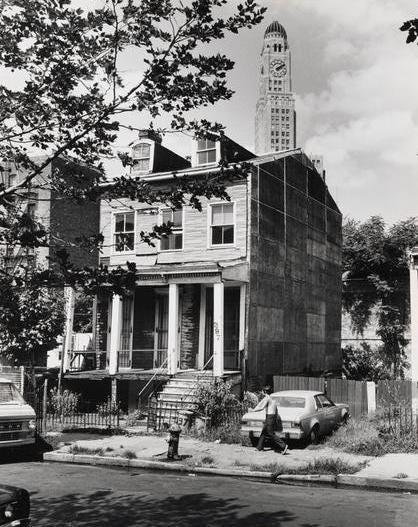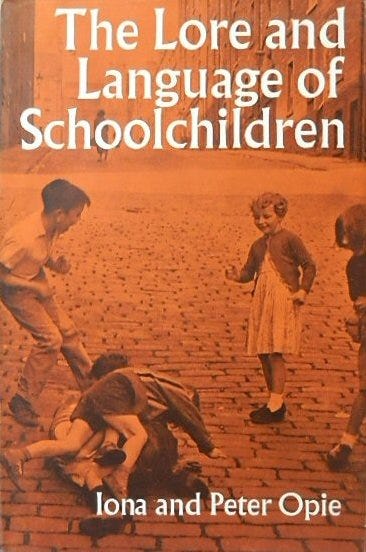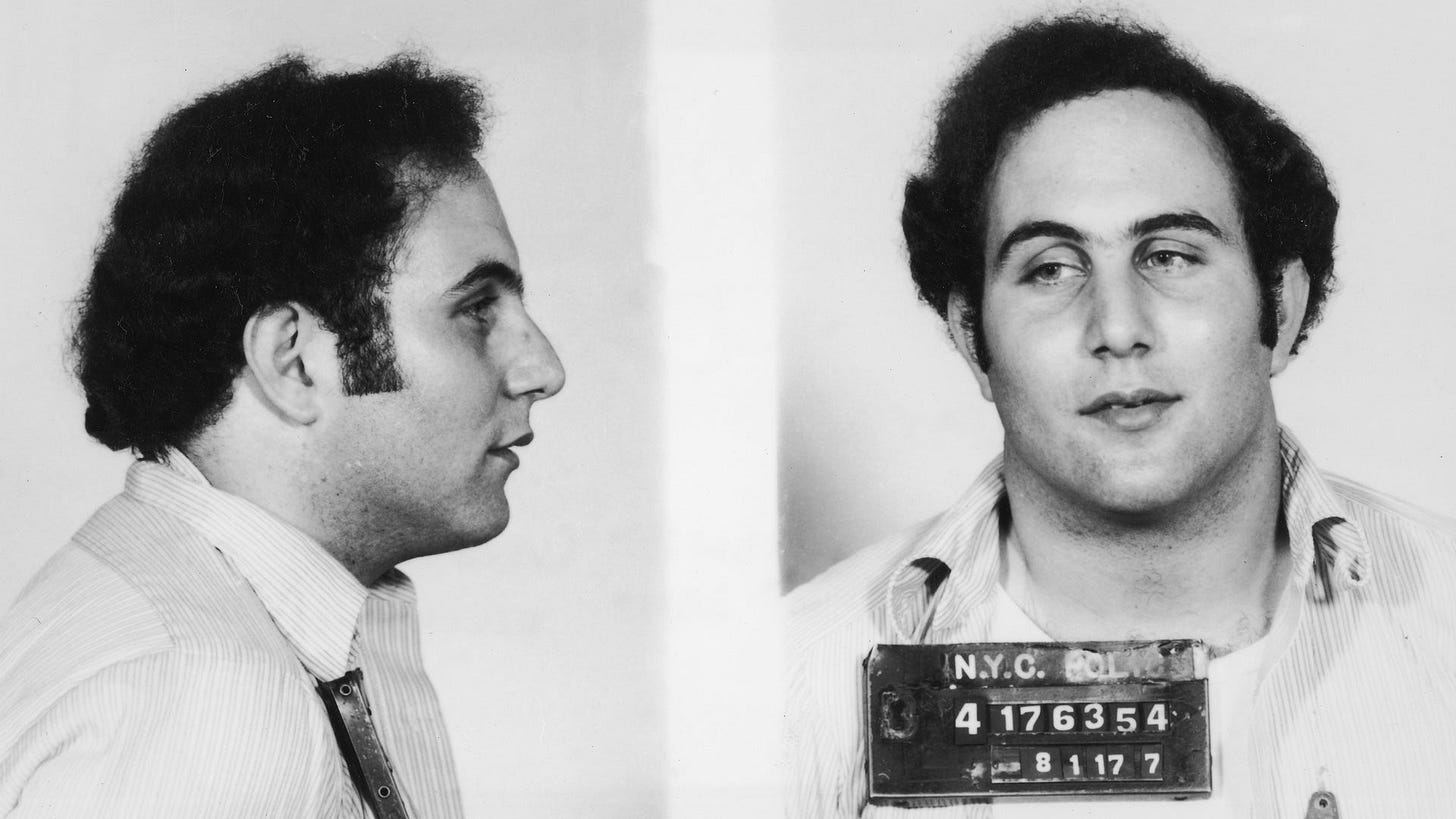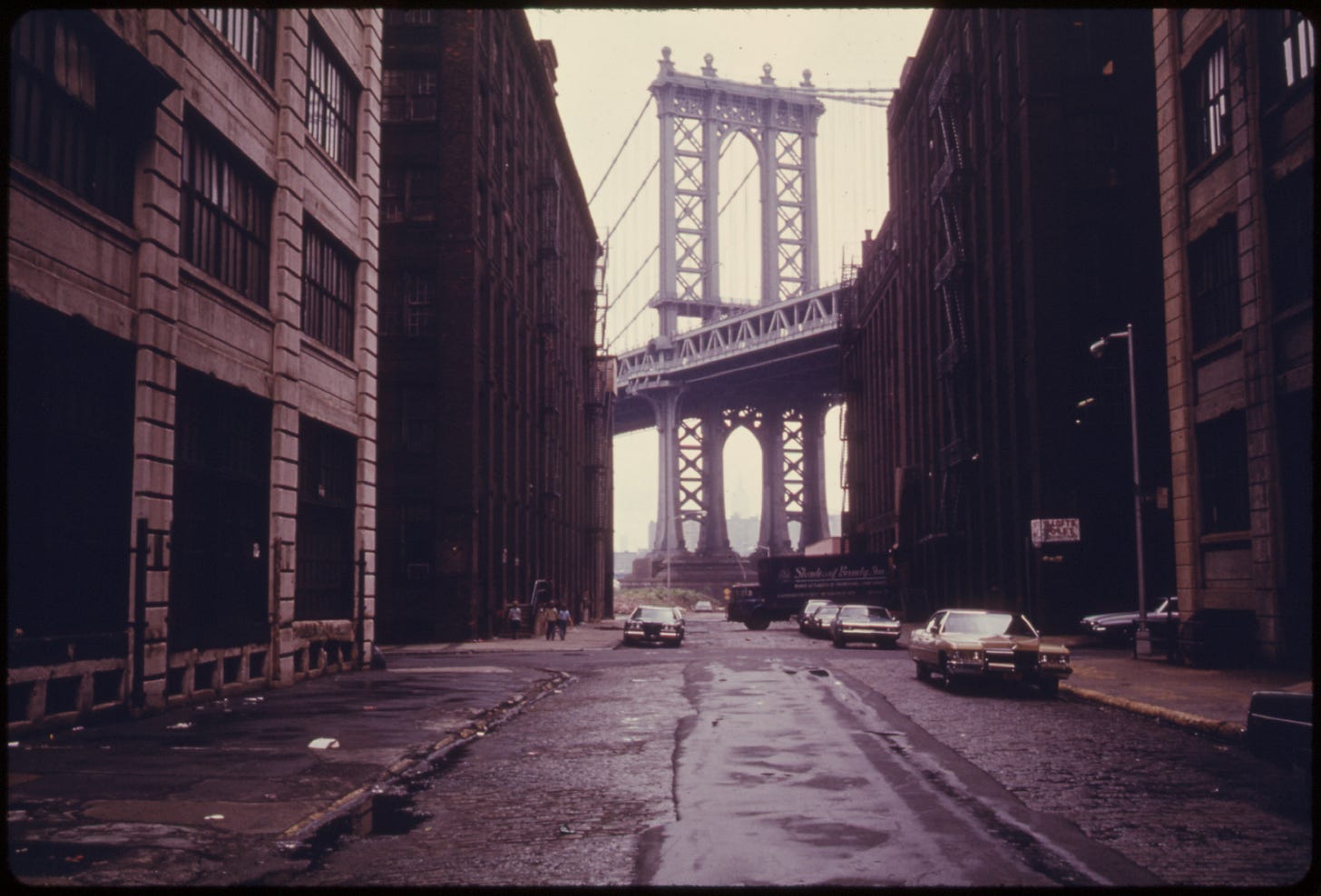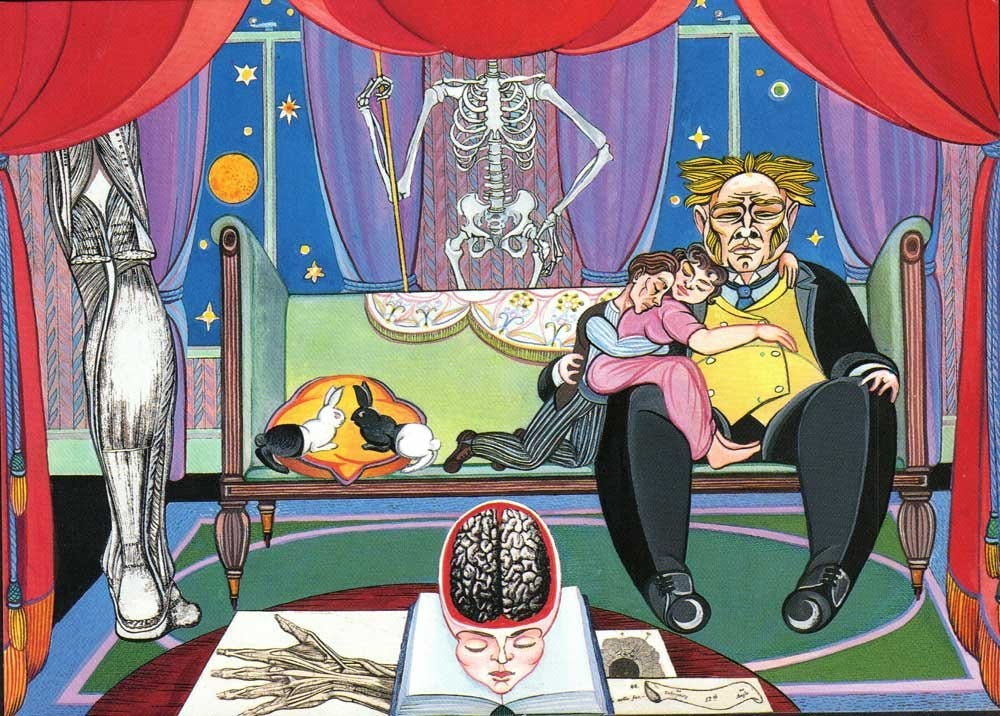Issue 34: Jonathan Lethem’s Not-Quite-Last Interview
"Did we just climb into our interviewer-and-interviewee costumes?"
Jonathan Lethem is the only novelist I can think of—although I could, erroneously, imagine others—who cites among his influences both Philip K. Dick and Barbara Pym. These names may seem at odds. Dick wrote science-fiction about paranoia and technology. Pym, mid-century comedies about the British middle-classes. But Pym was a secret modernist, and you could argue that Dick’s dystopias are satires of social anxiety. And Lethem—author of thirteen novels and counting, not to mention numerous short story collections and non-fiction books—is adept at turning genres and influences inside-out. He’s remade the the hard-boiled detective tale into a moving, humorous meditation on language and thought; he’s set stories of small-town American life at the end of the world; he’s rethought the family saga as a history of revolutionary politics.
Lethem’s latest, Brooklyn Crime Novel, revisits his childhood in 1970s Brooklyn, and takes the reader on a tour spanning fifty-years of his neighborhood. It is a bravura act of close reading; of what he calls “the dance” of street lore and games, of crimes and micro-traditions, of race and class and gentrification. It’s also the most funny, scary and tender local history of New York written since your favourite three-legged neighborhood stray cat got bulldozed under a fancy coffee shop.
I talked to Lethem about his new novel. From the off, the interview went in exactly the direction I had hoped: sideways and inside-out.
DAN FOX: We were talking over email about the ways in which ordinary aspects of an artist’s life can illuminate their work. I asked, “why do we not know the lunch preferences of the great artists?” What’s yours?
JONATHAN LETHEM: Typically cottage cheese, sardines, soft-boiled eggs and sauerkraut. But here’s the thing: did it help you to know?
DF: No. It was a terrible question.
JL: It’s strange how unsatisfying the reply was to type out. A few weeks ago I agreed to keep a food diary, for a weekly magazine with a popular feature on What Celebrities Eat. I did my best, worked to make it both real and charming, but there was something about consecrating my food choices into language that immediately drove everything into performance-eating. It quickly got intricately false. I feel a whisper of that same artifice overtaking my answer to your question. Is it just me and my toxic self-consciousness? Or did we just climb into our interviewer-and-interviewee costumes?
DF: Well, the wardrobe department here does have a great range of costumes to choose from. How about something from an old episode of Star Trek? Me: intrepid space explorer, lycra crewneck, boots, driven by a peaceable-yet-heavily-armed curiosity about intergalactic life. You: a purple cloud of gas floating in space, no legs or arms, only pure consciousness and a wise, baritone voice like Orson Welles, one of those highly-evolved alien species they conjured for the show when they’d run out of budget.
JL: There’s a double bind in this game. Either a Wizard of Oz screen erects itself, and we both gaze at the illusion there. Or else I act as though giving the gift of a glimpse behind the curtain, offering up ritual humbleness. Somehow, behind stumblebum cliches like “I have no system, I have to make it up every day” lurks the even more inchoate and awkward truth that the work seems to come out of a parallel life that is impossible to reconstruct by talking about it. It’s disavowals all the way down. Who scurried in and constructed these artworks, while I was out shopping for cottage cheese? Or I could erect a titanic refusal, in the spirit of “If you have to ask what I eat for lunch, you’ll never know!”
DF: Is it possible to show both sides of the curtain? To interview Jonathan Lethem and “Jonathan Lethem”?
JL: Obviously, I’m at the end of a long book tour, wondering whether interviews work or are broken. Somewhere I saw an Edward Gorey quote that I like, where he says, “I tend to think life is a pastiche. I’m not sure what it is a pastiche of—we haven’t found out yet.” I so want this interview to be different, Dan, not only because I’m fond of you. I want, for both of us, to do what Melville proposes in Moby Dick: “Strike through the mask.” That pasteboard mask, the pastiche behind which lies what neither Gorey nor I am certain of. The obvious risk is that I’ll deliver a Mannerist interview in the attempt. But if the risk is pretentiousness, I feel I’ve found my right correspondent in you.
DF: This is a safe space for pretentiousness. What do you hope will happen?
JL: There’s a series of small books from Melville House called “The Last Interview Series.” Featuring, of course, dead writers. And I think about Dennis Potter on Channel Four in 1994, doing his spellbinding “last interview” with Melvyn Bragg, while sipping from a flask of morphine to keep the cancer pain at bay. Yet despite the death-wish this invokes, I keep fantasizing about delivering my last interview, the one so complete or ridiculous or both that it would make a good small book and demand silence forever after. I don’t wish to be dead but for my interviewing self to be dead. Want to try this with me? One rule: we tell the truth: this is a written exchange. Which means it is automatically a lie. One lie it requires is the insertion of parenthetical diegetic sounds from the imaginary transcript. Like this one: [laughs]. You must leave them intact. For I am laughing, Dan. I am.
DF: I believe you. [Coughs, mutters.] What about “first interviews”? Nobody talks about those. They’re embarrassing. Media juvenilia. But that younger artist is still within the older artist somewhere, aren’t they? Does the “first interview” haunt the “last interview”?
JL: For sure. The longer I carry on, the more I’m haunted by all my early public gestures, as they dwindle into the rear-view. But what’s haunting isn’t simply regret or embarrassment. There’s also something more mysterious, when I glance back: wonder at the energy and certainty and ambition, at the scarless un-defensiveness of an artist who hadn’t ever been rebuked for overreach or pretension, or dismissed as overrated. Also, who’d had no notion—how could he?—how many times he’d be interviewed! How the remarks would pile up, contradicting one another, forming permanent heaps of steaming mulch in the fields of self-understanding.
DF: What’s your stage lunch today?
JL: Leftovers, from a Korean restaurant in Buena Park, called Honey Pig. That’s hours away still, since I’m writing from bed, at six in the morning. Envisioning those leftovers in the refrigerator is a secret compact with my afternoon self.
DF: Why do so many interviews with writers involve asking what time of day they write? You know, “I get up at five and write 2000 words before my first G&T at nine.” Why does it matter?
JL: Right, when do painters work? Or, for that matter, poets? Could it be that the only ones subject to this particular ritual curiosity are the novelists? The following may get at some of what you’re nibbling around in other questions, which may or may not get answered here. (And if I don’t answer them directly I’ll trim them out of the document, so then I’ll be alluding to their ghost-presences.) Nobody seems completely sure whether novel-writing is some kind of exalted Parnassus activity practiced by mysterious geniuses, or prosaic and therefore basically a kind of hoax—i.e., anyone could do it, if they just reproduced the material conditions, got up at the specified time of morning, and ground away for a few years, plus were ethically bankrupt enough to thinly-disguise details of their own and their friends’ personal lives. Add shameless disclosure to grinding work ethic, and voila: a novel appears.
It seems to me this never resolves, but just hovers and makes everyone anxious. So we have National Novel Writing Month, where everyone writes one. And, conversely, we have the Nobel, where humans are elevated to godhood. (There’s no Nobel for acting or painting or songwriting. And when the greatest songwriter who ever lived is given a Nobel, it’s somehow a catastrophic affront, as though he’s fine, but he’s no… novelist. He doesn’t even stack up against one of those forgotten Swedish ones.) Earlier you mention (or will mention) Pynchon…
DF: …I did but I had to cut him out for length…
JL: …well, his standard of not-eating-lunch is the one every other novelist is failing to meet, a kind of invisible Kafka starvation-artistry; as well, the shadow of Musil, or Proust, or the Russians is always lurking. These are totems to fail against. Musicians and poets and painters may practice their arts, and participate in their traditions, but novelists are usually betraying theirs. We lunch-eaters are not worthy of our own activity. And yet, as I say, at the same time that activity may only consist of setting one’s clock early enough; anyone might be one of us if they were boring enough. Over this logical gulf, the thinnest of bridges is stretched between contempt and worship. This may also have to do with the fact that we’re not meant to utter a single word in rebuttal of our critics—we’re simultaneously simpletons unqualified to contend with the profound scholarship of book reviewers, and we’re imperial icons not meant to demean our profession by condescending to notice them. Do I rant, Dan? I rant! [laughs]
DF: [Laughs nervously. Changes subject.] I’m fascinated by the way Brooklyn Crime Novel plays off detail against generalization. “We” versus “I.” Barely any characters have names—C. squeaks in with an initial—a few have nicknames, such as The Wheeze or The Slipper, but most are simply Dean Street boys, black boys, white boys, Brownstoners. At the same time you give the reader detailed insights into the rules of street games. (They have such evocative names: “throwing a Spaldeen,” “flicking a skully cap.”) You describe block-by-block demarcations of territory for the locals, you anatomize interior renovations the Brownstoners make to their houses, the names and locations of bodegas and bars and high schools and pizza joints. It’s as if one scale of information is constantly interrupting the other to say “yes, but look, it’s more complicated than that.” Nobody in the book has a name, but many are complex, contradictory, rounded characters.
JL: I like this characterization very much, but I’m not sure I ever thought about ‘scales of information’, so much as I freed the voice of the book to conduct a kind of inquiry that was by its nature obsessive, burrowing, gnawing. Yes, I’m thinking of “termite artistry,” but also that Columbo kind of persistence in investigation—picking up a cigarette butt and putting it in the pocket of a trenchcoat, then going to a bar and putting the cigarette butt up on the bar and staring at it through the duration of four drinks… Digression was built in, and also a kind of spiraling, perhaps even fractal kind of attention; things freeze for close-ups and exploded diagrams. So, yes, it ends up seeming to do with scale – your question gives me the gift of seeing it in those terms.
DF: [Blushes. Deletes mean question from further down the list.]
JL: What I did think about, constantly, was the strange push and pull of what I called “exclusions”—which you touch on in your question as well. Restricting myself against some, or even many, of the usual consolations of fictional prose, and the embrace of narrative conventions: character names, scenes built of thick sensory description. I left out my usual joy in ekphrasis and I tried to exclude citation of songs, or even portray the artistic appetite of any characters—there aren’t talented graffiti artists and budding rappers everywhere, even if in my experience there sometimes were. Excluded too was the surround of plot, or the promise of consecutive and uninterrupted attention—in every case I felt clear I was denying myself and the reader pleasures I might usually want to put in.
DF: And yet it’s not a minimalist project.
JL: The paradox was that the diminishing or excision of certain stuff was in the cause of making the book bigger with some other kind of possibility, or implication—I wanted to open it out from the inside. Sometimes I’ve had the thought that many innovative artists I admire take an interstitial element from earlier forms, and blow it up—like James Brown taking the rhythmic breaks in R&B and dispensing with the rest of the song, in favour of repeating those and building a tapestry of them. What I wanted to push to the foreground was the novel thinking about its own problems in being a novel in the first place. That, and the urgency of the traumatic memories around which it had formed, and for which it was trying to become a machine to contain.
DF: That again brings to mind Potter; his play Blue Remembered Hills, in which adults inhabit the roles of children to get to a deeper, tougher level of truth about the past. Brooklyn Crime Novel also made me think of Iona and Peter Opie’s The Lore and Language of Schoolchildren, an astonishing study of the rhymes, laws, games of school kids in the UK. It’s as if you’ve smuggled a collection of Brooklyn children’s folklore inside a novel, or vice versa.
JL: [A week goes by. I travel to Austin, Texas for a book festival. I come home. More lunches pass by, those I make and consume myself, and those I pack into lunchboxes. War atrocities rage in the distant background. Bombs landing on hospitals. Sorry for the grim turn my parentheticals have taken.]
This microcosmic forensic work consumed me for years. That sense that the book was like a ship in a bottle, that if I only could be precise enough with the glue and tweezers and exacto-knife, when I finished, the sails would rise. And then it could be photographed, my little ship, with one of those cameras that blurs the background and makes a tiny miniature appear to be real, if only for the duration of one picture. But that’s all I needed: to enter the past completely again, one single time. And then, strangely, I am also one of the tiny figures on the deck of the ship in the bottle.
I love that Opies book, and I devoted myself to the idea of “Street Games”, which is the title of two different short story collections I kept on the talismanic shelf beside my writing desk, along with all the studies of gentrification and the histories of Brooklyn and the early Gilbert Sorrentino novel from which I cribbed. Street games seemed to be precisely the category of clue I needed to trace, even when those games had no rules, and weren’t fun, and consisted only of language or body language or varieties of implicit threat—they all modeled as versions of game (or “dance”).
But your question speaks of folklore, too—and this was something I didn’t know, going into the project: that I’d become interested specifically in the manufacture of private experience—crime and trauma, mostly—into semi-public folklore, into local urban myth and legend. It began to seem to me that the children of the city, certainly of my part of Brooklyn, had an informal equivalent to the insane tabloid culture that ruled New York in those days. While the Daily News and the New York Post were processing certain citywide stories of violence and disruption into folklore in real time—Son of Sam, Bernhard Goetz, the vanishing of Etan Patz—we children were doing the same thing with the “famous” muggings and abuses of our own terrain. It was a process of hype but also of trauma-management. We processed our nightmares into lore and street cred. This also began to seem a parallel, to me, for so much early 20th-century artmaking: the way the devastation and nihilism of World War One becomes Modernism, and Surrealism, and the Hemingway and Hammett hard-boiled voice. Until, eventually, the soldier in a trench becomes Humphrey Bogart in a trenchcoat. And then Bogart becomes Woody Allen and Bugs Bunny. I’d adopted that style automatically, as a person and as a writer, from the start: the self-ironized endpoint Bogart narrator, who knows that his masculine bluster is a joke and a ruse, one who self-mugs before the mugger can get to him.
This describes the exoskeleton I had to step free of, to get to the truth in this book. And disassemble, and announce that I was disassembling. But then again, after all these years, what am I but a jellyfish, an unformed thing, without that exoskeleton? (If you prick me, do I not bleed Bugs Bunny’s blood?) So, I had to clamber back in at times, and move around inside the old mechanism—the hard-boiled, the street cred. I had to show you its tricks. The legends and lore, the street myths, they are a part of the truth, too.
DF: Is The Wheeze a stand-in for the critic? Barfly local historian, impressed by no one, but who deep down wants to feel seen, recognized for his expertise and custodianship of history and atmosphere. Was there a Wheeze sat at your shoulder when writing the book, a person whom you felt the story was both for but also a defense against?
JL: In an awestruck encounter at age 15 with Philip K. Dick’s just-published VALIS, I was made to understand that one of the ways a novelist can generate an energy-system amidst a group of characters is to split and distribute his or her own attributes among two or more fictional people. Dick makes this very literal with his “Philip K. Dick” and “Horselover Fat” characters, which was good for me as an adolescent, since I was at that time needing to have modernist craft devices demonstrated to me in very literal ways for them to sink in.
Fundamentally, that is to say, the relation between The Wheeze and the implied author/narrator of Brooklyn Crime Novel is a relation between parts of myself that I’ve sorted and distributed and fictionalized. In this way the two are a kind of rhyme for Perkus Tooth and Chase Insteadman in Chronic City, who were split from myself in similar proportions. Journeyman and Todbaum in The Arrest too. Then again, the Wheeze is a cartoon portrait of my own real-life genius secret-weapon research person, a Brooklyn obsessive of great talent and intuition and capacity with a microfiche archive, named Brian Berger.
DF: A legend. Brooklyn should name a library after him.
JL: He fed and provoked me throughout the work. And, then again, the Wheeze—his physical aspect, his manner of speech—is based on a guy whose name I never knew, a guy who used to hate on me at a bar in Brooklyn. And, then again, the Wheeze is based on The Lorax, from the Dr. Seuss book of that name.
This crazy accumulation of methods—the self-splitting-and-distributing, then the further conflation of different persons from life and characters from others’ fictions—this seems to be the only way I can make a character I can climb into at all. I’d say the same about the boys and the fathers in The Fortress of Solitude, about Pella Marsh from Girl In Landscape, about Rose Angrush and Cicero Lookins from Dissident Gardens.
I never once thought of the Wheeze as a projection of a book critic, however!
DF: If The Wheeze is you, and the implied narrator is you, what then of the other Dean Street white boys? Are they not also you?
JL: Good question. Again: are and aren’t. My strategies in this book take on a special desperation to skirt those traps of “confession” and “self-disclosure” which haunt any autobiographically-enriched characters, even if made indirect by exaggeration, conflation, distortion and omission. Obviously for me the prime example is that one lonely little white boy named Dylan Ebdus, from The Fortress of Solitude. Yes, I split tiny aspects—moments of encounter and consciousness—from myself into perhaps as many as a dozen characters in Brooklyn Crime Novel. But in many cases—confusingly, I’m sure, to the people involved!—I’ve spliced those aspects onto anecdotal “evidence”: stories about other people that recollected, or gathered in my research conversations with old friends and acquaintances from the neighborhood. The virus of my self-wonderment is like a cold that everyone is catching.
DF: The poet Roy Fisher has a lovely line about his home town in England: “Birmingham is what I think with.” Is the same true for you and Brooklyn? You’ve written neo-noirs, thrillers, family sagas and science-fictions and so many other kinds of stories. Are those all, in a way, also about Brooklyn?
JL: I love that line. I hadn’t heard it. Of course I thrum to it. Yes, for me there was a tremendous amount of writing preceding any direct approach to Brooklyn. Four novels and a multitude of short stories. Examined in the light of the Brooklyn books (and perhaps we should include the other New York books, especially Dissident Gardens, which is about identity in a different borough and generation) you can see all kinds of allegorizing of the same material in the science fiction. The mystery of urban sectarian zones, the feral life of children, the issues of race and class and gentrification, the fascination with special vernaculars of the street and stigmatic identities of various kinds. At the time I both was and wasn’t conscious of how the literal material of my life was pressing up against the interior surface of my inventions. Similarly, I find myself now resistant to any reductive suggestion that all the work preceding the Brooklyn books was merely avoidant. As if it was all just a preliminary to something more direct that was trying to be birthed. I’m not attracted to any idea that the writing between Fortress… and Brooklyn Crime Novel was a kind of skirting of my “main” work. If I’m honest, one of the places where I quietly puzzle over my own oeuvre is how much Motherless Brooklyn is taken as some kind of “coming-out” of my true writing self, when I don’t rate that novel as highly as the world tends to. I like Girl In Landscape, the one that precedes it, a lot better. Yet it’s undeniable that Motherless Brooklyn opens the door to the more direct work to follow, partly because among the tics I granted to the Tourettic narrator was a fascination with nomenclature and provenances—streets, ethnicities, vernacular philology—tendencies which were also new tools, to equip the writer I needed to become to write The Fortress of Solitude.
DF: Why do you think the world rates Motherless Brooklyn higher than you do?
JL: Well, this is one of those replies where I ought to remember to insert a lot of [laughs] or [laughs ruefully]. It’s ungracious to refuse love, and I don’t—I soak in it. I don’t find it inexplicable how that book became so popular. Nor why, as I continue to add more to the pile, it remains anomalous—un-followed-up by me, the unrepeatable trick. Two things: I’d just moved back to Brooklyn when I wrote it, and the book became an exhilarated valentine to the place. I rediscovered my zone of origin and wrote it a love letter, at a time when Brooklyn wasn’t so excessively and cloyingly celebrated, and in a mood where the darker undercurrents weren’t my preoccupation. Second thing: I made up this guy, Lionel Essrog, who’s just appallingly endearing. I don’t know why or how, exactly, but I do know that he isn’t me. Despite wearing the hard-boiled detective genre on its sleeve, I see that book as actually functioning within a different genre. One that’s unnamed, and smaller, but quite specific. It’s the “misunderstood sensitive freak” genre. A Catcher in the Rye, A Confederacy of Dunces, Flowers for Algernon, Harriet the Spy. The character is smarter and more sensitive than those around them, and treated badly by everyone, which arouses a protective love in the reader. How dare they? I did this on sheer instinct, not by calculation.
I probably just resent Lionel Essrog for being more loveable than I am [laughs]. I don’t like disappointing people who want me to be him [laughs ruefully.]
DF: Reverse the polarities. Is Brooklyn Crime Novel an end-of-the-world science fiction tale? It’s about a place you knew a certain way, knew its rules, its familiar faces, but which gets changed beyond recognition by forces no one can truly understand?
JL: Yes, of course, I see all my work as continuous in its insistent strangeness, and devotion to bringing something recognizeable but elusive to light—something that for me lies in conflating the prosaic and the surreal. Language is a technology of consciousness, one with strangeness, with dreaming, structured into it. But also, to undertake any halfway serious contemplation of the past—an undertaking which has become more and prominent in my work as I grow older and more of my existence is lived, helplessly, in the past—involves a voyage into the strange particularity of another world. In Brooklyn Crime Novel I felt I was trying to drag the reader back to a realm as distant and impossible as Mars.
DF: Or is Brooklyn Crime Novel a book about men? There’s a chapter in which you talk about how the neighbourhood girls are always “just outside the frame.” They’re mothers, they’re the occasional sister, a local character, but this account of Brooklyn concerns growing up male. It’s about how male friendships are formed, about parent-son relationships, violence, intimacy, fear, brains and brawn, social capital, group-think, sex, straight and gay desire, along with the myriad trivia that begins to clutter boys’ heads when they’re young then rusts there for life, a junkyard of facts about music, books, sports, history.
JL: So much is packed into this question. That’s just a warning about the length and intricacy of this reply.
Brooklyn Crime Novel is, in important ways I’ve tried not to be coy about, a fiction built on the materials of an oral history. The testimony, the memories, of witnesses. Those include myself, and also my brother and three of my best friends from childhood whose conversations helped me create The Fortress of Solitude. But further, in this case, a broad field of what I call, in my acknowledgments, my “rememberers.” Some were people I hadn’t seen since childhood. I sought them out and was fairly systematic about cultivating their contributions.
It happens that I’m a former boy, and so is my brother, and so are two of the three friends who’ve given me so much access over the years. It also happens – genuine happenstance—that this disproportion represented a truth about the immediate space all my rememberers were remembering: it was a boyish street I grew up on. There were girls, but not as many. So, this is one material fact in the matter.
A novel can never be about everything, though it isn’t uncommon for novels to yearn, at some point in their conception, toward “maximum inclusion”—especially multi-character social panoramas covering decades in the life of a place. It’s as natural for them to wish to represent every kind of everyone as it is for them to inevitably fail. This book suffered that same kind of aspirational collapse, to such a degree that it became one of the subjects of the book: the fact that one writer’s empathy might reach out in good faith toward so many versions of “other” and still fall painfully short of encompassing their subjectivities. In some cases, the voice of the book might make a foray, a probe, and then draw back. In other cases, simply cower at the threshold.
At some point, in order to be a book at all, not just a dream of climbing back into the past, I had to accept the circumscription of my material. In the case of this book I opted to talk about it openly within the pages, which is of course certain to be irritating to those who shudder at metafictional gestures, even glancing ones.
Now, the two previous Brooklyn books are both about groups of boys, and about sons and fathers, or surrogate fathers. This seems to be the terms by which I make my engagement with growing up in that time and place. I began to lose my mother to cancer when I was eleven, and she died when I was fourteen. I had a sister, but she was eight years younger, so our childhoods experiences were less overlapped. She became a crucial best friend and writer’s confidante later in my life (and is in fact strongly implicated in some of the material belonging to those girls nagging at the new book’s frame), but my brother and I coexisted in our life on those streets much more.
So, for those who feel my writing really begins with Motherless Brooklyn (see our talk above), I must seem like a very boyish author. This is confusing and irksome to me, since I’ve also written three novels from a predominantly female viewpoint: Girl in Landscape, You Don’t Love Me Yet, and The Feral Detective. And important portions of two others, Amnesia Moon and Dissident Gardens, are done from female points-of-view as well. And other books, like Chronic City and As She Climbed Across the Table present male characters defined by their relation to a strong female character—although those women also tend to be elusive, or to disappear part-way through the tale.
In Brooklyn Crime Novel, one of the everythings the book wished to be about was how one of the wellsprings of violence and despair in the experience between the boys on the street, along with race, and class, was the inadmissible management—the suppression, or projection, or deflection—of homosexual desire. I’d touched on this in The Fortress of Solitude, but incompletely, it seemed to me. My understanding had grown, including my understanding of my own experiences. I’d grown more convinced that this galvanic current ran through so many of the conflicted relations between boys, a panic that lay underneath other panics. It took a long time for me to get all the way there, and some side writing (see: “My Queer Jobs, Parts 1, 2 & 3”) about my own bisexual awareness. But for what it’s worth, I do feel I arrived at this topic completely in this book. It isn’t peeking from around the frame, but centered where it needs to be. Which hasn’t kept the general discomfort at naming this matter from playing a role in the readers’ and critics’ reaction to the book. That’s to say, barely anyone mentions it.
DF: We must soon step out of our costumes. (I fear the zipper at the back of mine has gotten stuck.) A custom at the end of artist interviews is to ask what’s next. But I often think a better question is: how do you move on to whatever is next?
JL: Perfect last question. My struggle to give it a good answer will be metonymic with the struggle that is its answer, which is to say it’s the struggle I’m currently engaged in. Believing that you’re done with a book like this one is difficult, even when it’s not only in the bookstores but on the verge of being returned and remaindered. An interview like this helps. Out of at least a decade of intention, and then three or four years of active whittling and carving and blacksmithing, I have assembled this gigantic and ridiculous trebuchet for hurling a single inchoate feeling out of the castle of myself and across great distances, into the castle of the unknown recipient, who remains permanently out of my sight or communication otherwise. Crouching behind my battlement, I wait to see a tiny puff of smoke go up across that other wall, or hear a faint voice cry “ouch!” Picture this like a Monty Python battle. Perhaps my recipient will toss out a cow or a chicken onto my head, I’m not sure. But questions like yours are the puff of smoke I’m looking for.
Why all the martial and medieval imagery? Well, the way to move on—the only real way—is to become fixated on some next thing, some impossible new confabulation of your deep thoughts and your self-amusement, placed in relation to artifacts beyond your understanding, stuff lying “out there” in cultural or geographical or historical space. An object of words that needs making, but only by your own measure—no one would ever call for it, and most, if you tried to explain it to them, would only shake their heads. I’m assembling thoughts in front of you, Dan. A book set in Southern California, about a castle full of actors who are playing knights in a kind of dinner theater. And then the knights go on strike. A novel. I’ll hurl it up over the wall for your consideration, about eight hundred lunches from now.
RECOMMENDATIONS
—Via Radio Alhara, a fundraiser to provide shelter to artists in Gaza. Organized by Al Kamandjâti (set up in 2002 to offer music lessons to Palestinian children), The Edward Said National Conservatory of Music, and the Delia Arts Foundation.
—Save the Children are raising money to help children and refugees displaced by the current conflict in Sudan, which has internally displaced over 7.1 million people.
—Artist Stanley Schtinter has released The Book of Genesis, Chapters 1—20, read last month in Polari at the Church of the Blessed Sacrament, Manhattan. “And Gloria cackled, Let there be sparkle: and there was sparkle.”
—Tish, a new film about the photographer Tish Murtha, and her images documenting working-class life in Britain, is out now in UK cinemas.
—If you liked Yorgos Lanthimos’s adaptation of Poor Things by Alasdair Gray, and you’re passing through Glasgow, you might enjoy this walking tour devised by Rachel Slocombe taking in locations from the original novel, developed in conjunction with The Alasdair Gray Archive.
—Sous Bois, composed in 1911 by Lili Boulanger. Heavenly.


